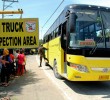DAVAO CITY – A recent survey conducted by Pulse Asia and the Social Weather Stations (SWS) showed majority of the Filipinos looked forward to next year with optimism.
The SWS survey showed 92 percent of Filipinos are hopeful this coming year, while the Pulse Asia survey showed 89 percent are hopeful in welcoming the new year.
Prof. Emeritus Leonor Magtolis Briones of Social Watch Philippines the optimist of Filipinos for the year 2016 “is not surprising”.
“As people of faith, they never lose hope that things will change for the better. They have remained optimistic during wars, famine, and natural, political and social calamities. They are looking forward to elections which will give them cash, free food, and temporary jobs,” said Briones.
However Briones said: “The question is: is the good news about 2016 sustainable?”
Briones said the expected spike in gross domestic product (GDP) next year will be driven by an election budget, and will not have sustainable impact for the poor and unemployed.
“Expecting a 7.5 percent to 8.5 percent growth next year, increased activity during elections and the year preceding it create a projection of progress and upward growth. This is brought about by election spending, which generates more jobs such as in construction and campaign work, albeit temporarily,” she said.
Briones said money spending will also affect banking and finance. She cited the Government Final Consumption Expenditure during the third quarter this year at 17.4 percent, which is way higher compared to -2.5 percent in the same period last year.”
But she said, the question remains whether election-driven growth will be sustained for the long term and whether it will directly benefit the poor and the marginalized.
“Will this be sustainable enough to lift people out of poverty?” Briones asked.
The Philippine Statistical Authority (PSA) said the GDP grew by 6.0 percent during the third quarter of 2015. However, its distribution remained dismal since the agriculture sector only posted 0.4 percent growth while the major growth drivers in services and industry sectors posted 7.3 percent and 5.4 percent growth respectively. On the other hand, PSA estimated poverty incidence among the Filipinos at 25.8 percent during the first semester of 2014. This will fall short of the MDG target of 17.2 percent by 2015.
Meanwhile, Social Weather Stations (SWS) found out that 15.7 percent of the Filipino families experienced involuntary hunger during the third quarter of this year.
There also seem to be a little change in unemployment and underemployment. During the third quarter of this year, PSA-National Statistical Office recorded unemployment at 6.5 percent and underemployment at 17.7 percent.
SWP said, a year before during the same period, unemployment stood at 6 percent, while underemployment at 18.7 percent.
“And considering that persons at work are defined by the Labor Force Survey as those working even for an hour a week, these figures appear understated,” the group said.
“While we are now looking at a P3-trillion budget next year, we must remember that poverty, unemployment and hunger virtually remained the same for the past nine years. Our poverty has moved down slowly according to MDG standards and as compared to our ASEAN counterparts,” said SWP co-convenor Marivic Raquiza
“We also failed to accomplish 19 out of 28 MDG indicators. These are proofs of the lack of correlation between economic growth and poverty and inequality,” she said.
Briones said this remains a challenge as the budget still includes lump sum amounts.
“This will remain a challenge if the red flags in the budget remain intact. Budgetary transfers and realignments brought about by the continued existence of pork, lump sums, and erroneous definition of savings will make it difficult for the reduction of poverty, inequality and hunger as well as employment generation,” she said.
“A huge budget does not certainly ensure that economic growth is enjoyed by all, especially the poor and vulnerable. It has to focus on the sectors where the poorest are and where unemployment is highest. Let us not forget the statement of NEDA Director General Balisacan, “economic growth is necessary but not sufficient for sustainable development,” Briones said. (davaotoday.com)










